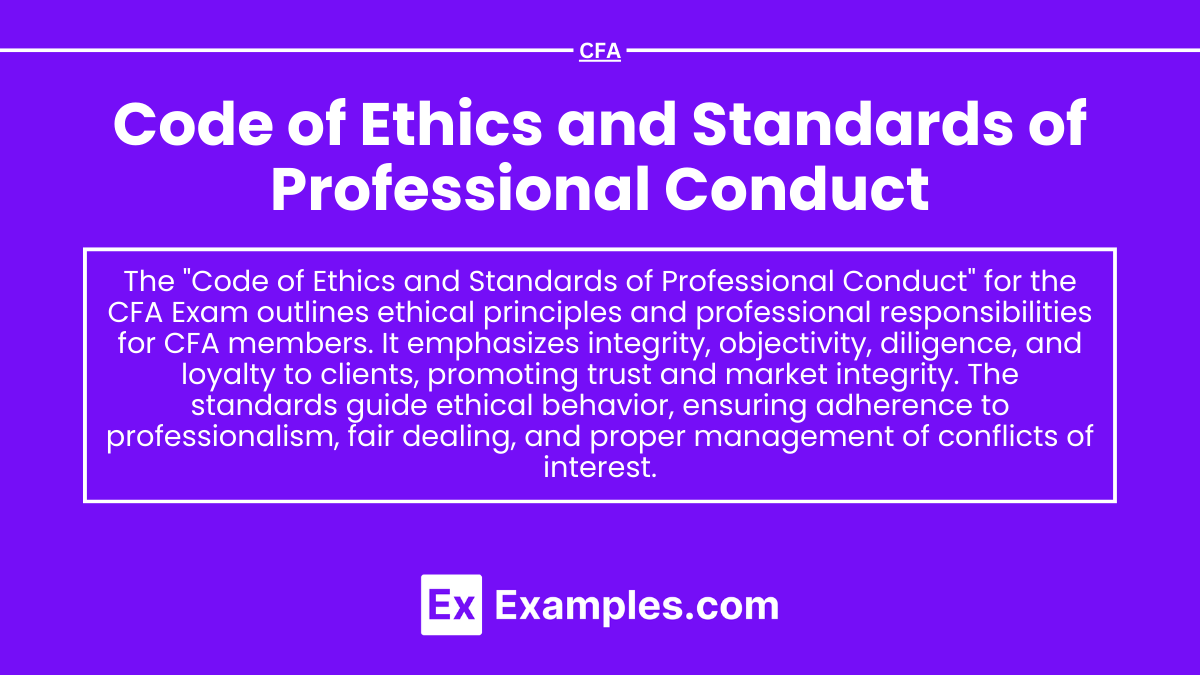Preparing for the CFA Exam requires a comprehensive understanding of the Code of Ethics and Standards of Professional Conduct, a fundamental aspect of professional practice. Mastery of ethical behavior, integrity, and professional standards is essential. This knowledge promotes trust, accountability, and adherence to the highest standards, crucial for success as a CFA charterholder.
Learning Objective
In studying the “Code of Ethics and Standards of Professional Conduct” for the CFA Exam, you should understand the ethical principles and professional responsibilities that guide CFA charterholders. Analyze key standards such as integrity, objectivity, diligence, loyalty to clients, and the responsibilities of CFA members and candidates. Evaluate ethical scenarios and apply the Standards to ensure compliance with professional obligations, foster trust, and maintain market integrity. Additionally, explore the importance of ethical decision-making, risk management, and accountability within the context of client relationships, investment analysis, and regulatory compliance as outlined in CFA Level 3 practice cases.
Ethical Principles and Professional Responsibilities
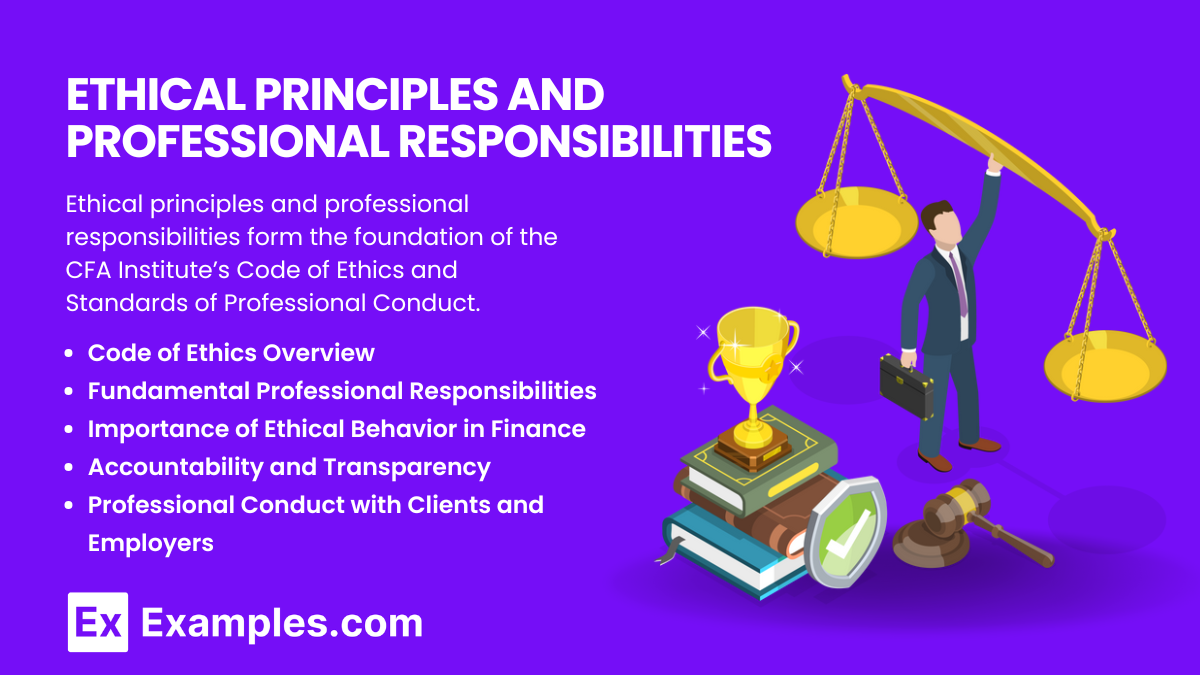
Ethical principles and professional responsibilities form the foundation of the CFA Institute’s Code of Ethics and Standards of Professional Conduct. These principles guide the behavior of CFA charterholders and candidates, ensuring they uphold the highest standards of professionalism, integrity, and ethical conduct in the financial industry. Here’s a detailed explanation:
1. Code of Ethics Overview:
The CFA Institute’s Code of Ethics outlines six key principles that guide ethical behavior for CFA members. These principles emphasize integrity, professionalism, client trust, and the promotion of ethical behavior across the industry. They include:
- Acting with integrity, competence, diligence, respect, and in an ethical manner with clients, employers, colleagues, and the public.
- Placing the integrity of the investment profession and client interests above personal interests.
- Practicing and encouraging others to follow professional and ethical standards.
- Promoting the integrity and viability of global capital markets.
- Maintaining and improving professional competence.
2. Fundamental Professional Responsibilities:
CFA charterholders have responsibilities that extend beyond achieving financial goals for their clients. They must:
- Uphold the Principles of Integrity and Fairness: Ensuring transparency, honesty, and ethical behavior in all dealings.
- Act with Objectivity and Independence: Making unbiased decisions and recommendations that prioritize client interests, free from conflicts of interest or outside influence.
- Maintain Professional Competence: Staying current with industry standards, market trends, and new regulations to deliver high-quality services.
3. Importance of Ethical Behavior in Finance:
Ethical conduct builds trust between financial professionals and their clients, employers, and the public. It fosters market integrity, which is critical for the proper functioning of financial markets. Ethical behavior ensures that clients’ best interests are prioritized, reduces the risk of misconduct, and enhances the reputation of the investment profession as a whole.
4. Accountability and Transparency:
Adhering to ethical principles means being accountable for one’s actions and maintaining transparency in communications and transactions. This includes providing clear and honest information to clients, disclosing conflicts of interest, and ensuring that all actions comply with applicable laws, regulations, and the CFA Institute’s Code and Standards.
5. Professional Conduct with Clients and Employers:
CFA charterholders must balance loyalty to their clients and employers while adhering to ethical principles. This means acting in clients’ best interests, protecting their confidentiality, and avoiding actions that could harm their employer or undermine public confidence in financial markets.
Standards of Professional Conduct
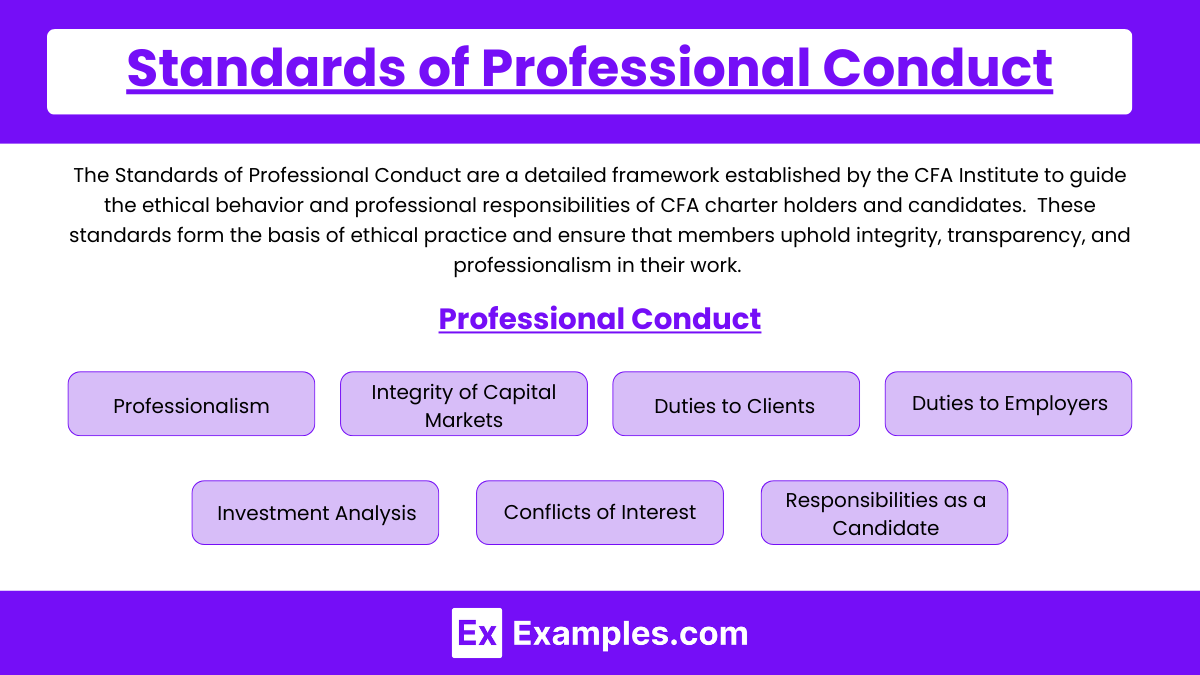
The Standards of Professional Conduct are a detailed framework established by the CFA Institute to guide the ethical behavior and professional responsibilities of CFA charterholders and candidates. These standards form the basis of ethical practice and ensure that members uphold integrity, transparency, and professionalism in their work. Here’s a detailed explanation of the key standards:
1. Professionalism:
This standard emphasizes the importance of maintaining high ethical and professional behavior in all aspects of work. Key elements include:
- Knowledge of the Law: CFA members must understand and comply with all relevant laws, rules, and regulations. When legal and ethical standards conflict, members should adhere to the stricter of the two.
- Independence and Objectivity: Members must avoid conflicts of interest that could compromise their impartiality. Gifts, compensation, or other incentives from clients or third parties should not influence investment recommendations.
- Misrepresentation: Members are prohibited from making any false or misleading statements, including exaggerating their qualifications or the performance of their work.
- Misconduct: Ethical misconduct, including dishonest behavior, fraud, and deceit, is strictly prohibited.
2. Integrity of Capital Markets:
This standard is designed to promote market integrity and fairness. Key components include:
- Material Nonpublic Information: Members must not act or cause others to act on material nonpublic information, as doing so creates an unfair market advantage and undermines trust in market integrity.
- Market Manipulation: Members are prohibited from engaging in practices that distort market prices or artificially influence market behavior for personal gain.
3. Duties to Clients:
CFA charterholders must prioritize the interests of their clients above their own. This standard encompasses:
- Loyalty, Prudence, and Care: Members must act with loyalty, exercise reasonable care, and place their clients’ interests ahead of their own.
- Fair Dealing: All clients must be treated fairly, and members should provide equal access to recommendations and investment actions.
- Suitability: Recommendations must be appropriate for the client’s financial objectives, risk tolerance, and circumstances. This involves conducting a thorough analysis of the client’s needs.
- Performance Presentation: Members must provide accurate and honest representations of their investment performance, avoiding any practices that could mislead clients.
- Preservation of Confidentiality: Client information must be kept confidential unless disclosure is required by law or consented to by the client.
4. Duties to Employers:
CFA charterholders have an obligation to act in their employer’s best interests and maintain loyalty. This includes:
- Loyalty and Safeguarding Proprietary Information: Members should not act in a way that competes with or harms their employer and must safeguard confidential information.
- Additional Compensation Arrangements: Any arrangements that may present a conflict of interest, such as external compensation, must be disclosed and approved by the employer.
5. Investment Analysis, Recommendations, and Actions:
This standard emphasizes the need for diligence, reasonable basis, and transparency in investment recommendations:
- Diligence and Reasonable Basis: Members must thoroughly analyze investment options and ensure that recommendations are supported by adequate research.
- Communication with Clients and Prospective Clients: All recommendations and strategies must be communicated clearly, including any risks and potential limitations.
- Record Retention: Maintaining appropriate records to support investment decisions and client communications is mandatory.
6. Conflicts of Interest:
To protect client trust and market integrity, members must disclose any conflicts of interest:
- Disclosure of Conflicts: Members must fully disclose any matters that could impair their objectivity or independence.
- Priority of Transactions: Transactions for clients should take precedence over transactions for the member’s personal accounts.
- Referral Fees: Any referral fees received must be disclosed to clients, highlighting any potential influence on recommendations.
7. Responsibilities as a CFA Member or Candidate:
CFA members and candidates must uphold the integrity of the CFA designation:
- Conduct as Participants in CFA Institute Programs: Members and candidates should conduct themselves professionally in relation to the CFA program.
- Reference to CFA Institute, the CFA Designation, and the CFA Program: Members and candidates must not misrepresent or exaggerate their CFA status.
Applying the Code and Standards to Ethical Scenarios
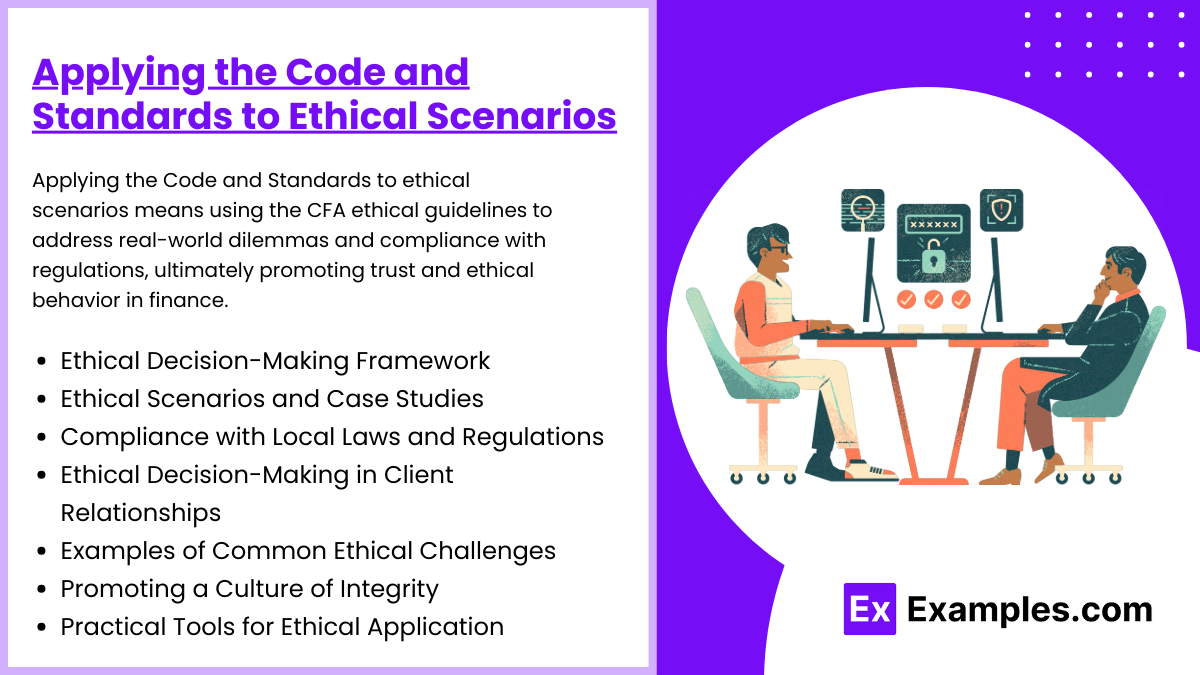
Applying the CFA Institute’s Code of Ethics and Standards of Professional Conduct to real-world ethical scenarios is critical for ensuring that CFA charterholders and candidates consistently act in the best interests of their clients, maintain market integrity, and uphold the highest standards of professionalism. Here’s a detailed explanation of how to approach and apply the Code and Standards in various ethical situations:
1. Ethical Decision-Making Framework:
To effectively navigate ethical dilemmas, CFA members should use a systematic decision-making framework that includes the following steps:
- Identify the Ethical Issues: Determine which aspects of the situation may present ethical concerns, conflicts of interest, or potential violations of the Code and Standards.
- Gather Relevant Information: Collect all pertinent facts and contextual details to fully understand the situation before making any decisions.
- Consider the Applicable Standards: Assess how the specific Code and Standards apply to the scenario, including Professionalism, Duties to Clients, Conflicts of Interest, etc.
- Evaluate Actions and Consequences: Consider the potential impact of different courses of action on clients, employers, and other stakeholders. Ensure that actions are consistent with ethical principles and legal requirements.
- Make a Decision and Take Appropriate Action: Choose the course of action that aligns with the Code and Standards, prioritizing client interests, market integrity, and ethical behavior.
- Reflect and Learn: After resolving the situation, reflect on the decision-making process and its outcomes to build ethical awareness and improve future decision-making.
2. Ethical Scenarios and Case Studies:
The application of the Code and Standards is often demonstrated through case studies and scenarios that highlight common ethical challenges faced by investment professionals. Examples include:
- Insider Trading: A CFA charterholder receives nonpublic, material information about a publicly traded company from a client. The appropriate action, as per the Standards, would be to refrain from acting on the information and ensure that neither they nor others use it for trading purposes, preserving market integrity.
- Conflicts of Interest: If a member receives a gift from a client that could influence their objectivity, the member must disclose the gift to their employer and ensure that it does not impair their independence in making investment recommendations.
- Fair Dealing: If a portfolio manager has an investment recommendation, they must distribute it fairly to all clients and not provide preferential treatment to any particular client or group.
3. Compliance with Local Laws and Regulations:
In situations where local laws and regulations conflict with the CFA Code and Standards, members must adhere to the stricter of the two sets of guidelines. This ensures ethical compliance while respecting legal obligations. For example, if local laws permit a certain type of trading activity that the CFA Standards prohibit, members should follow the CFA Standards and avoid engaging in the activity.
4. Ethical Decision-Making in Client Relationships:
Ethical scenarios often arise in the context of client relationships, such as:
- Suitability and Investment Recommendations: When providing investment recommendations, members must ensure that their advice is suitable for the client’s objectives, risk tolerance, and circumstances, and that all potential risks and limitations are communicated transparently.
- Client Confidentiality: Members must respect client confidentiality and only disclose information when required by law or with client consent. For example, discussing a client’s financial details without authorization would violate this standard.
5. Examples of Common Ethical Challenges:
- Performance Reporting: Misrepresenting past performance to attract clients is a violation of the Standards. Members must present accurate, honest, and complete performance results.
- Misrepresentation and Misconduct: Members must avoid making false claims about their qualifications, services, or the products they offer. Transparency and integrity are essential.
- Referral Fees and Compensation Arrangements: All compensation arrangements, including referral fees, must be disclosed to clients, as failure to do so creates conflicts of interest.
6. Promoting a Culture of Integrity:
By applying the Code and Standards to daily practices, CFA members promote a culture of integrity within their organizations and the industry. This involves leading by example, encouraging ethical behavior among colleagues, and addressing unethical conduct when it occurs.
7. Practical Tools for Ethical Application:
- Ethics Training and Continuing Education: Regular training helps members stay up-to-date with changes in the Code and Standards, enhancing their ability to apply them effectively.
- Consulting Compliance Departments: Members should consult their firm’s compliance or legal departments for guidance when facing ethical dilemmas that may require additional expertise.
Ethical Decision-Making, Risk Management, and Client Relationships
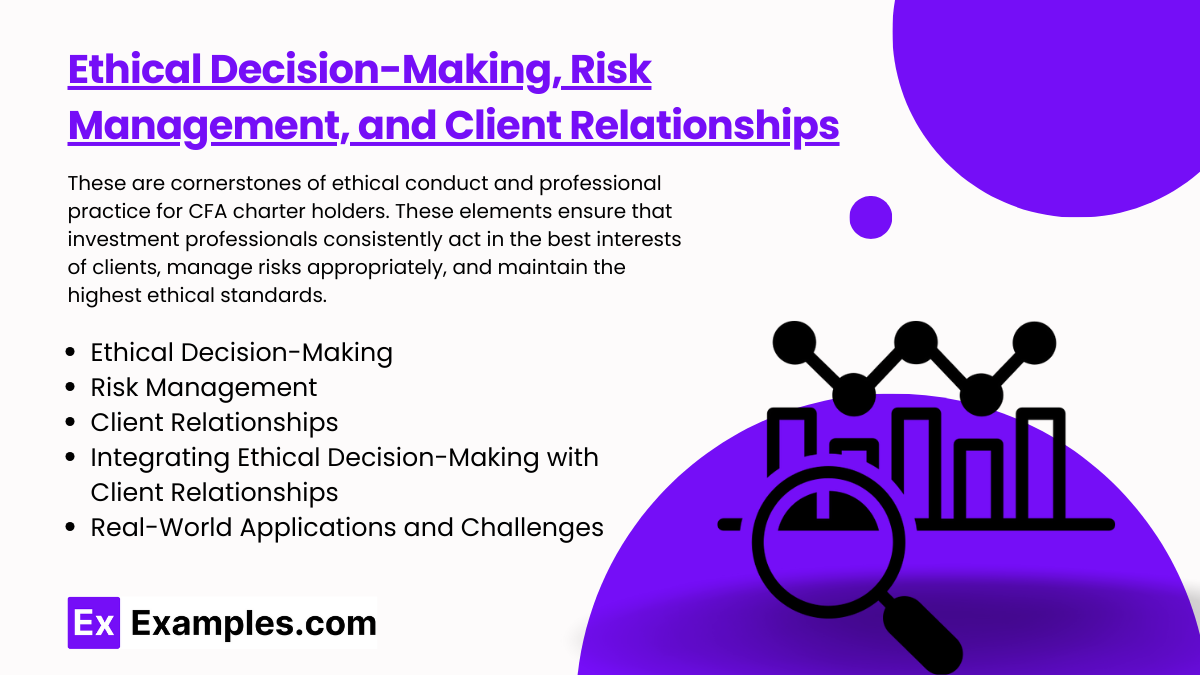
Ethical decision-making, risk management, and strong client relationships are cornerstones of ethical conduct and professional practice for CFA charterholders. These elements ensure that investment professionals consistently act in the best interests of clients, manage risks appropriately, and maintain the highest ethical standards. Here’s an in-depth explanation of each component:
1. Ethical Decision-Making: Ethical decision-making involves a systematic process to resolve ethical dilemmas while adhering to the CFA Institute’s Code of Ethics and Standards of Professional Conduct. The aim is to ensure that all decisions prioritize integrity, fairness, and transparency. Key steps include:
- Identifying Ethical Issues: Recognize when a situation presents a potential conflict of interest, unfair practice, or violation of ethical principles.
- Gathering and Analyzing Information: Collect all relevant facts to fully understand the context and potential implications of different actions.
- Consulting the Code and Standards: Determine how the specific standards apply to the situation. For example, issues related to client confidentiality, fair dealing, or conflicts of interest should be evaluated against the appropriate standards.
- Evaluating Possible Actions: Consider the impact of different courses of action on all stakeholders, including clients, employers, and the broader market.
- Taking Ethical Action: Choose and implement the course of action that best aligns with ethical standards and professional responsibilities.
- Reflecting on Outcomes: Review the decision and its impact to improve future decision-making.
2. Risk Management: Risk management is a critical function for investment professionals, aimed at identifying, assessing, and mitigating risks that may impact client portfolios, firms, or the broader market. Ethical risk management focuses on maintaining client trust and protecting their assets, as well as safeguarding market integrity.
- Identifying Risks: Risks can arise from market fluctuations, regulatory changes, conflicts of interest, and unethical behavior. Ethical professionals must actively monitor and address such risks to minimize their impact.
- Implementing Controls and Policies: Effective controls, such as compliance policies, code of conduct training, and internal audits, are vital for managing risk. These controls help ensure adherence to ethical standards and reduce the likelihood of unethical behavior or regulatory violations.
- Conflict of Interest Management: Active management of conflicts of interest, such as disclosing personal holdings or compensation arrangements, is necessary to prevent biases or unethical behavior that could harm clients or undermine trust.
- Maintaining Independence and Objectivity: Risk management also involves ensuring that recommendations and investment decisions are free from external influences that could compromise the professional’s independence or objectivity.
3. Client Relationships: Building and maintaining strong client relationships is essential for earning trust, meeting client objectives, and upholding ethical standards. This requires transparency, diligence, and a commitment to client welfare above all else.
- Acting in the Client’s Best Interest: CFA charterholders have a fiduciary duty to act with loyalty, prudence, and care. This means prioritizing client needs over personal or organizational interests, providing suitable recommendations, and avoiding conflicts of interest.
- Transparent Communication: Ethical client relationships depend on honest, transparent, and clear communication. Professionals should fully disclose risks, potential conflicts, and any fees or compensation arrangements that may influence their advice.
- Confidentiality: Safeguarding client information is a key component of building trust. Professionals must respect client confidentiality unless legally obligated to disclose information or given explicit client consent.
- Fair Dealing: Treating all clients equitably, without favoritism or bias, ensures fair access to recommendations, investment actions, and communications. This enhances market integrity and client trust.
- Ongoing Monitoring and Adaptation: Client needs and market conditions can change over time, requiring continuous portfolio monitoring and adjustments. Maintaining an open dialogue with clients helps ensure that portfolios remain aligned with their goals, risk tolerance, and evolving circumstances.
4. Integrating Ethical Decision-Making with Client Relationships and Risk Management: Ethical decision-making, risk management, and client relationships are interconnected. For example, managing conflicts of interest requires transparency and adherence to ethical principles, which in turn strengthens client relationships. Ethical risk management practices reduce the likelihood of unethical conduct, which protects client interests and market stability.
5. Real-World Applications and Challenges:
- Conflicts of Interest: Disclosing and managing conflicts, such as compensation arrangements, ensures that client interests are not compromised.
- Client Education: Educating clients about potential risks, investment strategies, and market conditions demonstrates a commitment to transparency and ethical behavior.
- Proactive Risk Mitigation: Identifying and mitigating risks, such as market downturns or regulatory violations, protects both the client and the firm from adverse outcomes.
Examples
Example 1: Integrity and Professionalism
A CFA charterholder refuses a substantial gift from a client that could compromise their objectivity. By adhering to the standard on independence and objectivity, the charterholder demonstrates their commitment to acting in the client’s best interest without being influenced by external incentives.
Example 2: Conflicts of Interest Disclosure
A portfolio manager discloses their personal stake in a company being considered for inclusion in client portfolios. By providing full disclosure, the manager upholds transparency and ensures that the client can make informed decisions about potential conflicts.
Example 3: Material Nonpublic Information
A CFA candidate receives nonpublic information about a company’s upcoming merger. The candidate refrains from trading on the information and ensures that others do not act on it, in compliance with the standards on market integrity and fair dealing.
Example 4: Suitability of Investment Recommendations
An investment advisor thoroughly analyzes a client’s financial objectives, risk tolerance, and investment horizon before making recommendations. The advisor ensures that all recommendations align with the client’s needs, demonstrating adherence to the standard on suitability and diligence.
Example 5: Fair Dealing
A research analyst releases a new investment recommendation to all clients simultaneously, avoiding preferential treatment. This practice exemplifies the fair dealing standard, ensuring equal access to critical information and maintaining market fairness and integrity.
Practice Questions
Question 1:
Which of the following is a key component of the CFA Institute’s Code of Ethics?
A) Maximizing personal profits from client transactions
B) Prioritizing the interests of the CFA Institute over clients
C) Acting with integrity, competence, and respect for others
D) Ensuring all clients receive the same investment returns
Answer: C) Acting with integrity, competence, and respect for others
Explanation:
The CFA Institute’s Code of Ethics requires members to act with integrity, competence, diligence, respect, and in an ethical manner with clients, employers, colleagues, and the public. It emphasizes professionalism and ethical behavior in all professional activities, unlike prioritizing personal or organizational interests over clients.
Question 2:
A CFA member receives nonpublic, material information about a company through their position as a consultant. Which action is most in line with the Standards of Professional Conduct?
A) Trading on the information to benefit their portfolio
B) Sharing the information with select clients
C) Taking no investment action based on the information
D) Disclosing the information to the public immediately
Answer: C) Taking no investment action based on the information
Explanation:
Under the Standards of Professional Conduct, members must not act or cause others to act on material nonpublic information. Trading on such information is considered insider trading, which undermines market integrity and is strictly prohibited.
Question 3:
Which of the following best describes fair dealing as outlined by the CFA Standards?
A) Providing recommendations to select clients based on their relationship status
B) Offering different levels of service to different clients without clear terms
C) Treating all clients fairly and providing equal access to recommendations
D) Favoring high-net-worth clients over others in distributing new recommendations
Answer: C) Treating all clients fairly and providing equal access to recommendations
Explanation:
Fair dealing requires members to treat all clients fairly and impartially, ensuring that they receive equal access to investment recommendations and actions. Preferential treatment based on client status or wealth contradicts the ethical standards set by the CFA Institute.

